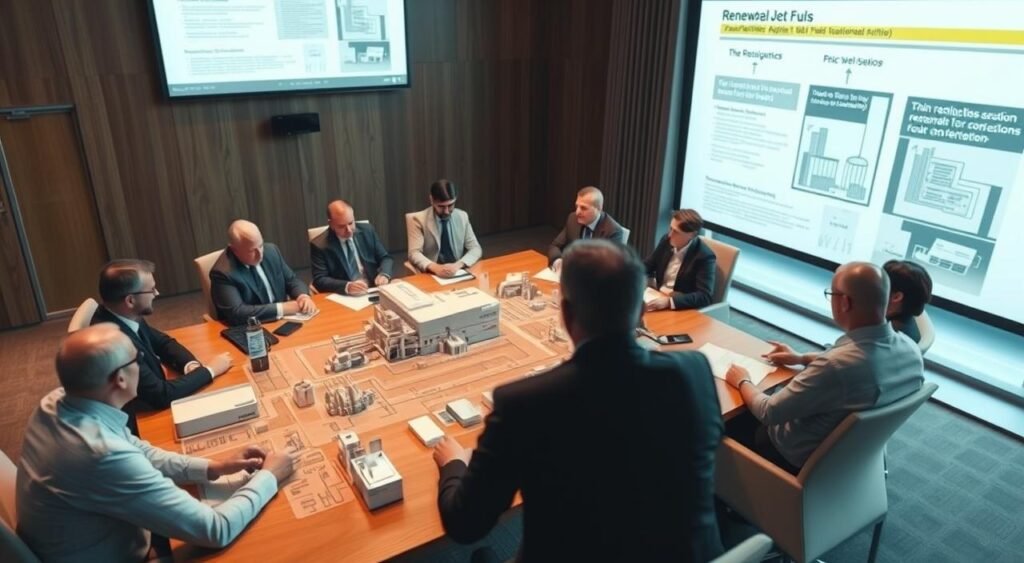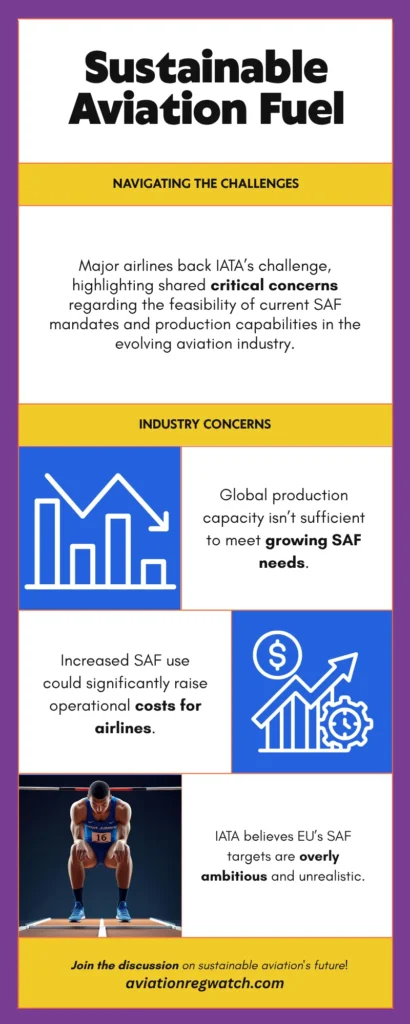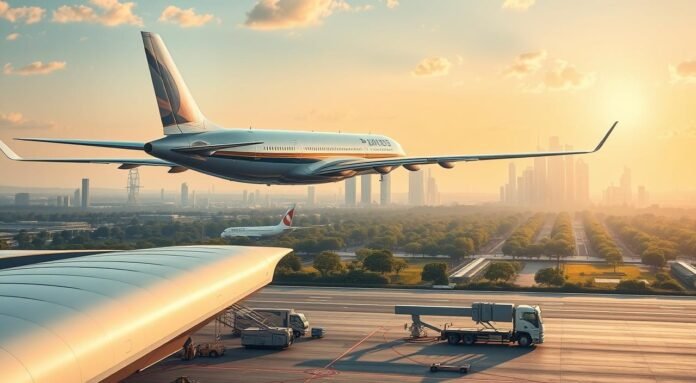IATA criticizes EU's Sustainable Aviation Fuel mandate targets too ambitious, citing economic and environmental concerns over limited global SAF production.The International Air Transport Association (IATA) has raised concerns about the European Union’s Sustainable Aviation Fuel mandate targets. IATA is of the opinion that these targets could have big economic and environmental effects.
The organization believes the EU’s ambitious mandate might be too hard to meet particularly due to the limited scope of the current global SAF production capacity.
IATA thinks there has to have a smarter way to use Sustainable Aviation Fuel (SAF) by balancing our green goals with the cost of achieving them.
Given the present challenges, it is too big a problem to switch to sustainable aviation fuels as mandated by the EU, argued IATA.
Objections to EU’s Sustainable Aviation Fuel Mandate: Key Takeaways
- IATA criticizes the EU’s SAF mandate as overly ambitious.
- Limited global SAF production is a significant concern.
- Economic and environmental implications are at the forefront.
- A balanced approach to SAF policies is necessary.
- IATA advocates for a more feasible SAF blending target.
EU’s SAF Mandate and Its Requirements
The European Union has a plan to make flying greener, by drastically reducing the greenhouse gas emissions from flying. The Sustainable Aviation Fuel mandate plays a crucial role in this plan.
Key Components of the European Sustainable Aviation Fuel Directive
The European Sustainable Aviation Fuel Mandate sets rules for using SAF. It defines SAF, outlines how it should be made, and ensures everyone follows the rules.
This directive helps make using SAF easier by setting clear rules.
Blending Percentage Targets Through 2050
The EU has big plans for using SAF in flying. They want to use more and more SAF over time. Here’s what they plan:
| Year | Blending Percentage Target |
|---|---|
| 2025 | 2% |
| 2030 | 5% |
| 2035 | 10% |
| 2040 | 20% |
| 2050 | 63% |
Implementation Timeline for Airlines
As per the plan, airlines need to follow the EU’s SAF madate starting in 2025. They will have to use more and more SAF over time. This gives them time to get ready.
Greener Goals Behind the Mandate
The EU wants to make flying better for the planet. They aim to cut down on greenhouse gas emissions from flying by more and more of SAF in a time-bound manner and make flying cleaner.

Industry Worries Over SAF Mandate
IATA’s objections to the Sustainable Aviation Fuel mandate reflects the industry’s worries over its economic and other practical implications.

IATA’s statement and paper explain that the goal of cutting carbon emissions is good, but the rules might be too hard to follow. The position paper says the EU’s SAF goals could hurt airlines’ budgets, making flights more expensive for everyone.
Many big airlines are backing IATA’s fight against the EU’s SAF rules.They fear these rules could raise costs and mess up flights and want rules that fit the industry’s current abilities.
Big airlines like Lufthansa and British Airways support IATA’s challenge. They think the EU’s Sustainable Aviation Fuel Mandate goals are too high and can’t be met on time.
The unified stance by these airlines shows their dedication to being green, but they also stress the need for realistic rules.
Economic Burden Analysis of SAF Implementation
It’s important to know how these changes are going to affect the airlines’ financial position. SAF will make flying more expensive for airlines, as it costs more than regular jet fuel and limited supply
The price difference between SAF and jet fuel could be huge. It might even double or triple what airlines pay for fuel.
Further, airlines also need to spend on new infrastructure such as updating storage, transport, and maintenance. This adds to the cost.
Passenger Fare Impact Projections
Higher costs for SAF will likely mean higher ticket prices. Fares could go up a lot. This might make people want to fly less.
Willie Walsh, IATA’s Director General, said, “We want to cut carbon, but we must do it without hurting airlines or passengers.”
“Moving to SAF is a big step for green flying. But we need to plan carefully to avoid hurting our wallets.”
Environmental Efficacy Concerns Raised by IATA
IATA has raised important environmental concerns about the EU’s SAF rules because of the limitations on SAF production capacity. They think the measures to fix the supply gaps could harm the environment.
Global SAF Production Capacity Limitations
IATA argues that the world can’t make more SAF to meet the EU’s big targets as we don’t have enough places to make SAF.
Key limitations include:
- Limited production facilities
- Insufficient feedstock supply
- Technological constraints
Sustainability Certification and Carbon Accounting Issues
IATA is worried about how SAF is made and counted in carbon emissions. It’s important to make sure SAF is made in a green way. This helps the EU’s SAF rules work better for the planet.
Feedstock Sustainability Questions
IATA is concerned about where SAF’s ingredients come from. They want to make sure these ingredients don’t harm the environment. This includes not causing deforestation or land damage.
Life-Cycle Emissions Analysis
It’s key to know how much carbon SAF really saves. IATA wants clear methods to measure this. This way, we can really see how much SAF helps the environment.

Supply-Demand Mismatch in the SAF Market
A big problem in the aviation world is the gap between SAF supply and demand. The EU wants to use more SAF to cut down on carbon emissions. But, there’s not enough SAF being made to meet this goal.
Current Global Production Capabilities
Right now, we can’t make enough SAF to meet the needs of flying. Most places making SAF are just starting or making a little bit. Most of the SAF made is in a few areas, and it’s not enough for the planes.
EU Demand Projections vs. Available Supply
The EU has big plans for using more SAF in planes. But, there’s not enough SAF to go around. This means there’s a big gap between what’s needed and what’s available. We need to make a lot more SAF to meet the EU’s goals.
Regional Production Disparities
Some places, like the EU and North America, are working hard to make more SAF. But, other areas are not keeping up. This will be big challenge to get enough SAF for everyone.
SAF making technology is getting better. New ways to make SAF and improve existing ones are being developed. However, we need to make SAF faster enough to meet the EU’s targets.
European Commission’s Response to Industry Concerns
The European Commission has listened to IATA’s worries about the SAF mandate. They are thinking about changing the policy. This could include adjusting blending targets and timelines.
Possible Compromise Solutions and Timeline Revisions
There are a few ways to solve the problem. One idea is to let airlines use different ways to meet SAF goals. This could include buying SAF credits or investing in SAF projects.
International Coordination Efforts
Another idea is to work together globally to make more SAF. This could mean working with governments, airlines, and SAF makers to build new facilities and supply chains.
| Potential Adjustments | Description | Impact |
|---|---|---|
| Revised Blending Targets | Adjusting the percentage of SAF to be blended into conventional jet fuel | Reduced burden on airlines, gradual increase in SAF adoption |
| Extended Timelines | Extending the deadlines for achieving SAF blending targets | More time for airlines to adapt, possible delay in carbon reduction |
| Alternative Compliance Mechanisms | Introducing mechanisms like SAF credits or investment in SAF production | Flexibility for airlines, possible increase in SAF supply |
Sustainable Aviation Fuel Mandate: Conclusion
The aviation industry is at a crossroads. It must cut down on carbon emissions while staying in business. The European Union wants to make flying greener with new rules on renewable jet fuel.
But, the International Air Transport Association (IATA) worries about the EU’s big plans. They think it might be too hard to meet the targets.
Finding a middle ground is key. We need to look at the cost of green fuel, its real impact, and if there’s enough of it. The EU needs to listen to the industry and find a way to make flying greener without hurting the industry too much.
Changing the timeline and setting more achievable goals could help. This way, the industry can start using cleaner technologies. It will help reduce the carbon footprint of flying.

